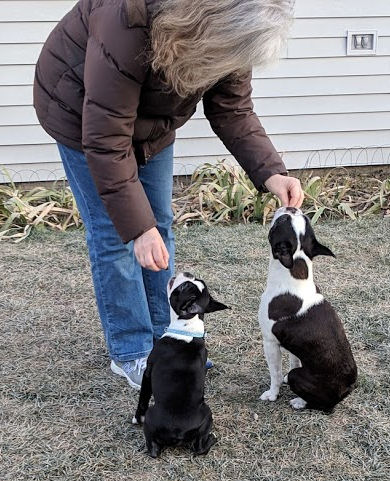Life would be easier if everybody would just do what you want, wouldn’t it? But people have this pesky attitude that their opinion matters, too. Just like life, there’s give and take in dog training.
In a civilized society, the two points of view hash it out and come to a mutually satisfactory conclusion. Nobody gets everything they want, but everybody gets something.
Dog training’s like that. You want your dog to behave. Your dog may have a different, or fuzzy, idea of what “behaving” looks like. How do you reconcile those different opinions?
Pick your battles
There are three ways of resolving behavior issues with your dog:
Ignore it:

This is for the things that you wish your dog didn’t do, but aren’t worth the energy to change. It’s different for everyone. And it depends on the dog. Booker and Simon (Fran’s Boston Terriers) both love to eat grass outside in the yard. Booker seems to have a cast-iron stomach. But eating grass (and dirt) makes Simon throw up. It was worth the effort to teach Simon to “Leave it!” for everything in the yard.
Is it fair there’s one rule for Simon and a different one for Booker? Probably not. But no one’s ever guaranteed that life is fair. The dogs don’t seem to notice, or care. As long as everyone gets a cookie when the treat pouch comes out, they’re all fine.
Manage it:
Managing the environment is how to deal with irritations you’re in the process of training, but haven’t gotten there yet. If your dog steals shoes, everybody puts their shoes away behind closet doors. If your dog is a counter-surfer, nothing’s on the counter.
This is also where the “tools” come into play. If your dog constantly pulls on leash, while you’re working on loose-leash walking, you can certainly use a no-pull harness. While you’re teaching your dog not to eat grass, control access by taking them out on leash and collar, even in your yard.
A friend of ours is a top-notch dog manager. And up until now, a complete failure at clicker-training, or game-based dog training. We tried. She just didn’t have the patience to let her dogs make decisions. Instead, she’s always told them what to do. Her current dog is having confidence issues her commands can’t fix. For this dog, whether she likes it or not, she’s learning to be patient.
Train it:
This is where you set your priorities. If you’re in a multi-generational family with toddlers or older people, your priority may be that your dog doesn’t jump on people. (2-Minute Trainer Method Book 4: Impulse Control) One of our students last session has balance issues, so her priority is loose-leash walking. Another wants to take her dog to the dog park and hiking, so the recall (Book 2: Come!) was top on her list.
Everybody’s priorities are different. These are the battles you choose to “fight” with frequent, short games that teach your dog the behavior you want. If you want your dog to stay quietly in their “place” while your family is at the dinner table, you sit at the dinner table and play “Place!” (Book 1: Clicker and Place) for a couple minutes every day.
Nobody can teach their dog everything all at once. And dogs can’t absorb it that way. Fortunately, once you and your dog are in the habit of playing training games, you’ll get around to all of it in time.
Give a little, take a little
You’re not a bad dog owner, or a quitter, if there are battles you choose not to fight. Management is fine, if it works for you, your family, and your dog.
Our most obvious one is at meal time. All of our dogs eat in their crates (in the dining room) at the same time we eat. No worrying about who’s eating which food. We’re not concerned about resource guarding. There are no suspicious silences from other parts of the house, and no hooliganizing wrestling matches. It’s a time we opt for peace, quiet, and not having to pay attention to the dogs.
In a way, that’s dog training, too. There’s no fussing in the crates, and no resistance to them. When the food preparation starts, the dogs go dashing to their respective crates. Everybody knows the rules, and happily abides by them.






